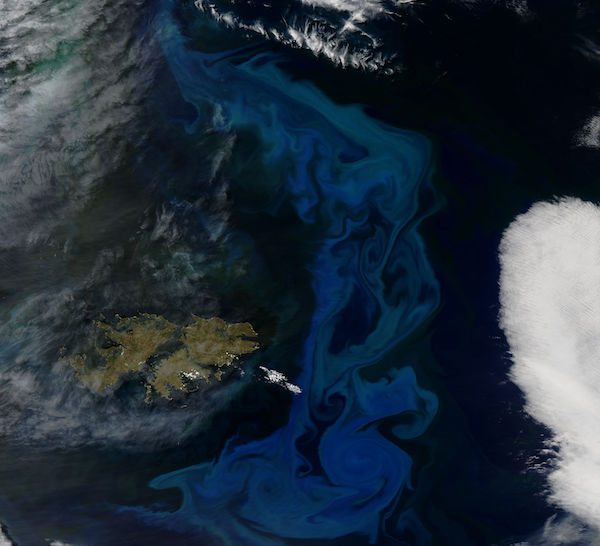Images
January 2, 2018 - Phytoplankton bloom off the Falkland Islands
Tweet
A river of jewel-toned colors floated for hundreds of miles in the upper layers of the South Atlantic Ocean in late December 2017. The Moderate Resolution Imaging Spectroradiometer (MODIS) aboard NASA’s Aqua satellite acquired a true-color image of the glorious greens and milky-hued blues on December 28.
These colors are created by millions of tiny, single-celled plant-like organisms floating in the ocean. These organisms, known as phytoplankton, contain chlorophyll and other pigments which reflect light and create beautiful colors which are easily seen from space. Phytoplankton live in these waters in small numbers all year long. It is only when conditions are just right – ocean water temperature, nutrients, and daylight length – that they begin to reproduce explosively and created huge blooms such as this one.
This bloom stretches hundreds of miles and follows the course of the Malvinas Current (Falkland Current), which sweeps north around the Falkland Islands and long the east coast of South America. A branch of the Antarctic Circumpolar Current, the strong current is cold and laden with nutrients. Because the current brings nutrients into the sunlit surface waters where plants can grow, the Malvinas Current often feeds large blooms such as this one.
Image Facts
Satellite:
Aqua
Date Acquired: 12/28/2017
Resolutions:
1km (157.6 KB), 500m (483.2 KB), 250m (1.2 MB)
Bands Used: 1,4,3
Image Credit:
Jeff Schmaltz, MODIS Land Rapid Response Team, NASA GSFC
Tweet
A river of jewel-toned colors floated for hundreds of miles in the upper layers of the South Atlantic Ocean in late December 2017. The Moderate Resolution Imaging Spectroradiometer (MODIS) aboard NASA’s Aqua satellite acquired a true-color image of the glorious greens and milky-hued blues on December 28.
These colors are created by millions of tiny, single-celled plant-like organisms floating in the ocean. These organisms, known as phytoplankton, contain chlorophyll and other pigments which reflect light and create beautiful colors which are easily seen from space. Phytoplankton live in these waters in small numbers all year long. It is only when conditions are just right – ocean water temperature, nutrients, and daylight length – that they begin to reproduce explosively and created huge blooms such as this one.
This bloom stretches hundreds of miles and follows the course of the Malvinas Current (Falkland Current), which sweeps north around the Falkland Islands and long the east coast of South America. A branch of the Antarctic Circumpolar Current, the strong current is cold and laden with nutrients. Because the current brings nutrients into the sunlit surface waters where plants can grow, the Malvinas Current often feeds large blooms such as this one.
Image Facts
Satellite:
Aqua
Date Acquired: 12/28/2017
Resolutions:
1km (157.6 KB), 500m (483.2 KB), 250m (1.2 MB)
Bands Used: 1,4,3
Image Credit:
Jeff Schmaltz, MODIS Land Rapid Response Team, NASA GSFC




